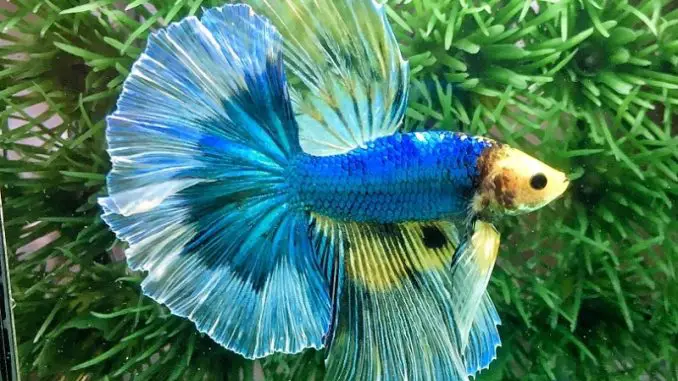
The butterfly betta is a much-sought-after freshwater tropical fish. It is extremely popular, both because of its striking and unusual colors and its distinctive shape.
This freshwater fish is among the many varieties of magnificent tropical fish that are commonly known as Betta.
The species is also sometimes called the Siamese fighting fish because the male betta is known to be highly aggressive and will frequently get into fights with other males of the same species.
TABLE OF CONTENTS
Butterfly Betta Facts & Overview
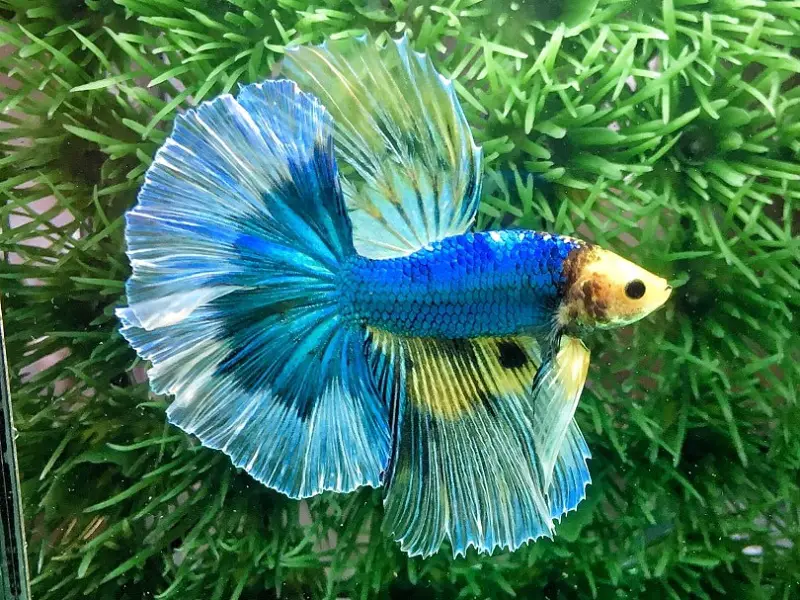
| Category | Rating |
| Care Level: | Moderate |
| Temperament: | Aggressive male |
| Color: | Orange, red, yellow, green |
| Lifespan: | Up to 5 years |
| Size: | 2.5 -3 inches |
| Diet: | Carnivore |
| Family: | Osphronemidae |
| Minimum Tank Size: | 5 gallons |
| Tank Set-Up: | Freshwater, mild current, 76° Fahrenheit |
| Compatibility: | Other small freshwater fish |
There is a wide range of types of betta fish. There are different varieties that have been bred to give a particular look, as these fish are easy to cross-breed.
Enthusiastic aquarists are constantly introducing new varieties as they come up with different ideas for a new ‘look’ in these diverse tropical fish.
The butterfly betta, also sometimes called the Halfmoon Butterfly Betta, is one of the more unusual varieties of Betta. It is known for its spectacular coloring, coming in a wide range of exceptionally bright colors, such as primary colors like red, yellow, and blue, as well as other bright shades of, orange, green and purple.
The butterfly betta also stands out because of its unique shape. As it befits its name, it is shaped a little like a butterfly.
The scientific name of the butterfly betta is the Betta splendens. These fish are often referred to simply as the betta. They belong to the family of Osphronemidae, which are all freshwater fish.
The Butterfly Betta has a labyrinth organ. This is a common characteristic among all varieties of Betta. This makes them known as anabantoids.
As a result of this unusual organ, Bettas have the unique ability to inhale oxygen from above the surface of the water. However, the Butterfly Betta also uses its gills to breathe in oxygen underwater, like all other fish.
The male Butterfly Betta is known to have an extremely aggressive temperament. Most male Bettas, no matter which variety, display this unfortunate characteristic.
It is in the nature of the male Betta to turn on other fish of the same species. This is why Betta are often also called Siamese Fighting Fish.
The Betta species was originally native to certain areas of Southeast Asia. These fish are frequently seen in the rivers and swamplands of Thailand, Cambodia, Indonesia, and Vietnam.
Thailand was formerly known as Siam. Hence the name Siamese Fighting Fish. Siam became Thailand in 1939, but the name Siamese Fighting Fish remains to this day.
Typical Behavior
The butterfly betta male is known to be a very territorial little fish. If he thinks that his territory is under threat of being invaded, he will turn on any other male betta that appears to be in his space.
He will attack with his fins and tail, making them stiff and firm, and thrash out with them. He will also try to bite any fish that he perceives to be a threat to his dominion over his territory.
It is sometimes a good idea to give the male Butterfly Betta his own tank, as these solitary fish are often best left to their own devices and are quite content with their own company.
You may think that this means that you can never keep any other fish together with your Butterfly Betta in a community aquarium. Fortunately, this is not the case.
You can pair the Butterfly Betta up with other freshwater tropical fish, but you should give careful consideration to the selection of his tank mates.
It is advisable only to choose other species of fish that the Butterfly Betta will not consider to be a threat to his territory.
If you want to know whether your Butterfly Betta is at ease and happy in his aquarium, have a look at what he is doing with his fins and tail.
When he is happy, and at ease, his fins and tail will be moving softly and gently. They will be completely flaccid and waving about freely in the water.
However, if you observe that his fins and tail are extremely stiff and taught, it is probably a sign that he is feeling as though his territory is being invaded, and he needs to protect it. He will be getting ready to attack.
Rapid, frenetic swimming from one end of the tank to the other, bumping into things around him and bumping his nose against the bottom of the tank, is usually an indication that your Butterfly Betta is feeling very stressed and anxious.
Appearance
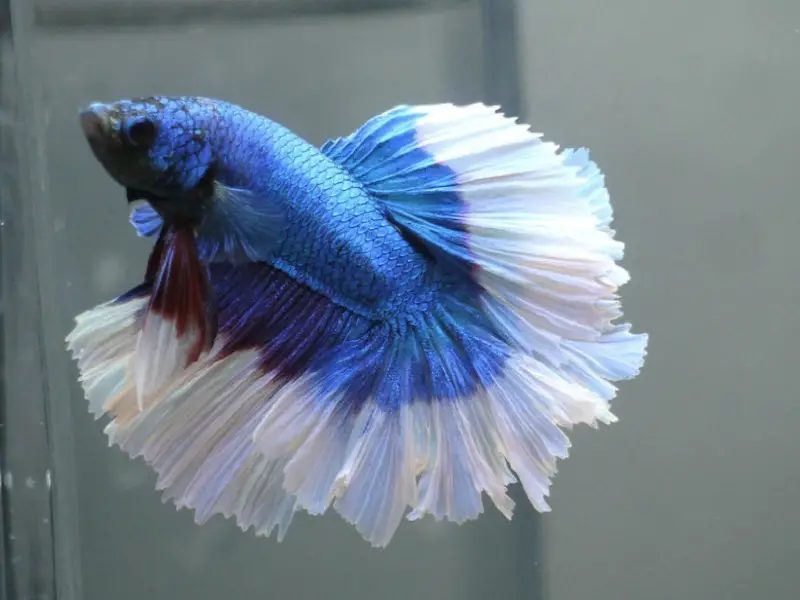
The Butterfly Betta is a popular choice for the home aquarium because it has a magnificent and unusual appearance. This tropical fish is bred in a broad array of strikingly bright colors.
The colors that are seen most often are bright royal blue, red, yellow, orange, green, and purple. In addition to their bright colors, the Butterfly Betta also stands out because of their shiny, iridescent shimmer.
It is quite common to see that the males often have brighter colors, while the females are usually somewhat less vibrant in color.
If you notice that your Butterfly Betta seems to suddenly start changing color, this could be a bad sign. It may be the first sign that your fish is not feeling well or that it is under stress and feeling threatened.
Often when disease sets in with Betta fish, it makes their bright colors fade to a much more dull shade.
The Butterfly Betta is quite small compared to many other tropical fish. A fully grown adult male will not be longer than 2 ½ -3 inches, while a female is even smaller.
Habitat and Tank Conditions
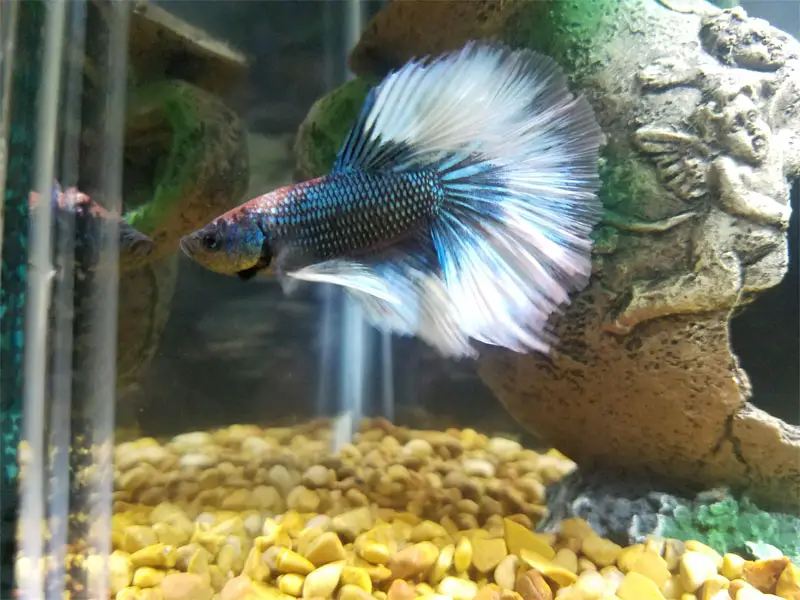
The Betta species originates from the rivers and marshes of Southeast Asia, where the water is never very cold. Therefore the Butterfly Betta is not used to extreme water temperatures. It will not survive in very cold water and only likes fairly warm water.
The waters of the rivers in its native Southeast Asia are usually so slow-moving that they are almost stagnant. There is very little current. The Butterfly Betta likes aquarium water that is similar to these conditions.
Tank Conditions
The Butterfly Betta will do best in an aquarium with moderate water parameters.
This species does not do well in very cold water. If the water is below 70°, it will be too cold for your Butterfly Betta and may kill it.
The water should be maintained at about 75°. This can be done with the help of a water heater.
The delicate fins and tail of the Butterfly Betta may be damaged if the current in the water is too strong. Therefore the water should be slow-moving, with a soft, mild current.
The Butterfly Betta does not enjoy very hard water. The water in its aquarium should have a dGH, or degree of General Hardness, of between 5 and 20.
The pH of the water should be kept at between 6.8 and 7 in order to keep your Butterfly Betta healthy.
A good aquarium light will enhance the appearance of the striking colors of your Butterfly Betta. Your fish will also be more comfortable under the correct light conditions.
Butterfly Bettas like to swim around and hide in little crevices and under plants. In order for plants to survive in the tank, they will need light.
It is a good idea to select soft and pliable plants and that do not have rigid, sharp edges that can damage the delicate fins and tail of the Butterfly Betta.
One or two rocks will give your Butterfly Betta some interesting places to hide, but these should always have a smooth and even surface with no jagged edges that will harm the fish.
What Size Aquarium Do They Need?
The Butterfly Betta is an extremely active fish. It needs enough space to be able to swim around freely. A 5-gallon tank would be a suitable size for a single Butterfly Betta.
If you are keen on a community tank with more than one fish, you will need a bigger tank.
Tank Mates
The male Butterfly Betta is a highly aggressive fish, particularly towards other male Bettas of any variety.
If he is placed in an aquarium with other bettas, he will consider them to be a threat to his territory, and he is likely to attack them. Therefore other male Bettas should not be placed in the same tank.
Male Butterfly Bettas will usually be quite happy to share a tank with other female Bettas, but they should be observed carefully to ensure that they are compatible.
The Butterfly Betta can safely share a community tank with other species of tropical freshwater fish, but his tank mates should be slightly smaller than him and peaceful in nature in order to prevent him from turning on them.
Some tropical fish that would be suitable tank mates for the butterfly betta are cory fish, guppies, kuhli loaches, and ghost shrimp.
Most of these fish will be compatible with the Butterfly Betta, and he should be quite happy to share his space with them without feeling as though his territory is being invaded.
Diet
The Betta species is a carnivorous fish. The Butterfly Betta enjoys eating meaty foods like fresh bloodworms, brine shrimp, and mosquito larvae.
Live food is the best choice, but he will also enjoy eating both freeze-dried and frozen meat-based foods.
The Butterfly Betta can also be fed high-quality fish food flakes or pellets. These should be well-known brand fish foods that have a high protein content.
One of the biggest dangers with a home aquarium is that of overfeeding your fish. The Butterfly Betta is a very small fish. It only needs a small amount of food every day.
It is so easy to fall into the trap of giving too much food. Overfeeding will make your fish bloated, constipated, and very sick. It may even kill him eventually.
A single meal portion should be a very small quantity of food. However, the Butterfly Betta does need feeding at regular intervals, twice a day.
The Butterfly Betta is smart enough to learn his feeding schedule and swim to the top of the tank as soon as he sees you approaching feeding time.
Care
The Butterfly Betta is not a complicated fish to keep in your home aquarium. It requires only a moderate level of care. The most important aspect of caring for this fish is ensuring that the water parameters are moderate.
Keeping the tank clean can be time-consuming but essential for the well-being of your Butterfly Betta. Algae and other harmful bacteria build up very quickly.
These can cause your fish to become seriously ill and may even kill it. The only way to prevent this is to be meticulous about keeping the tank and the water scrupulously clean. It should be cleaned at least every two weeks.
Ensure that you siphon the gravel and replace at least 10-15% of the water every time you clean the tank.
The levels of essential minerals in the water need to be checked and adjusted regularly. Elements such as calcium, strontium, magnesium and other trace elements should be kept at a steady level.
We recommend regularly using a commercial water testing kit to test your aquarium’s mineral levels and water parameters. If any deficiencies are detected, they should be rectified immediately.
Breeding the Butterfly Betta
Breeding most species of Betta is a fairly straightforward process. The Butterfly Betta reaches maturity and is ready to breed at around six months old.
Attempting to breed with Butterfly Betta that is younger than six months is not likely to yield successful results. Their organs are not yet fully developed or mature enough for procreation.
The chances of a successful outcome will be better if the breeding pair are given a tank of their own. They are not likely to breed if there are other fish sharing their tank.
The male Butterfly Betta will only breed with a female that is slightly smaller than him. A bigger female may make him feel threatened or intimidated, and he will be wary of approaching her.
It is sometimes difficult to tell when your Butterfly Betta is ready for breeding, but there are certain subtle signs. The female will usually change color very slightly. Her color will become slightly darker, and you may notice a faint stripe down her body.
If you see a white dot between her fins, this is an indication that her ovipositor is filling up, and she is about to lay eggs. It would be a suitable time to introduce the male.
You may also observe that the female is acting in a coy, flirtatious manner towards her mate. She will start to wave her tail and flare her fins towards him. This is her sign that she is ready to receive him.
Unfortunately, all Betta fish have the nasty habit of occasionally eating their own eggs. The female Butterfly Betta will also do this.
The way to avoid this happening is to ensure that there are a lot of little crevices in the tank. The eggs will settle in these spaces, where the female will not be able to reach them.
This can be achieved by having a substrate of gravel in the tank, with an assortment of marbles scattered around the bottom. The eggs will find their way into the little spaces to develop in safety and eventually hatch.
Is the Butterfly Betta Suitable for Your Aquarium?
Take the necessary steps to ensure that your Butterfly Betta is either alone in its aquarium or paired with suitably compatible tank mates. This exquisite, colorful fish will be a lovely addition to your aquarium.
Remember to maintain the right balance in the water parameters and follow our guidelines for all tank conditions. Your Butterfly Betta will be quite happy as long as he has enough space to swim around in a sparkling clean tank.
Even though the Butterfly Betta only has a relatively short life span, if you are guided by our recommendations your Butterfly Betta should live quite happily for a few years.
The Butterfly Betta does have certain needs when it comes to its care, but it is not a difficult fish to keep, and its needs are not complicated. If the idea of having one of these magnificent fish in your aquarium appeals to you, you should go ahead.


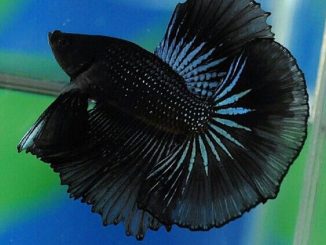

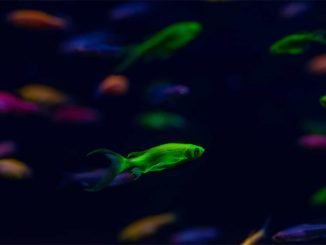
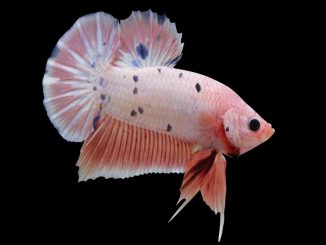
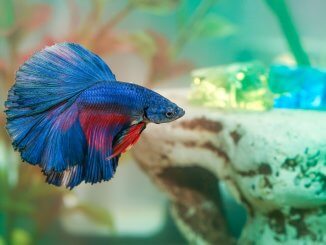
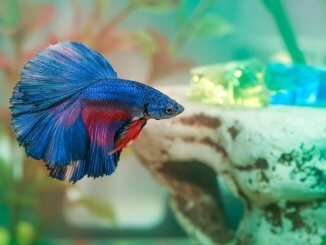
Be the first to comment